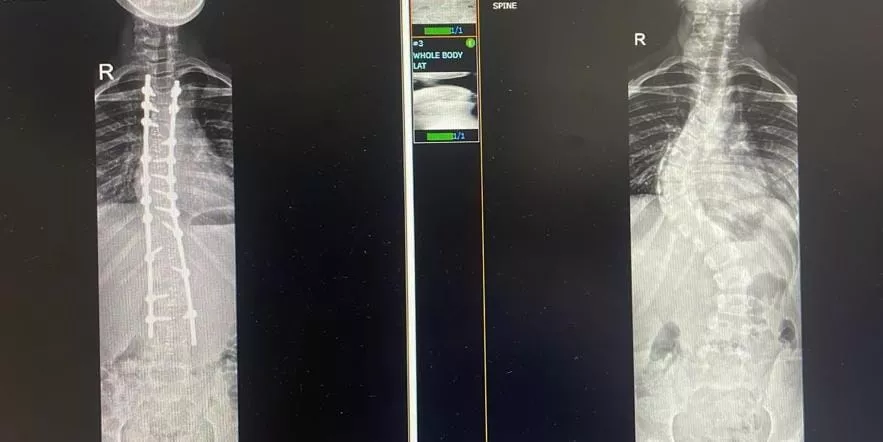Scoliosis is the medical term for a sideways curvature of the spine. While most people with mild scoliosis will not require surgery, in some cases it may be recommended. Without proper treatment, scoliosis may worsen and pose serious health complications including damage to heart or lungs, reduced mobility or chronic pain. Further, the deformity itself may be cosmetically unappealing. Surgery, thus, becomes necessary at times. Being a significant procedure, scoliosis surgery can be life-changing for individuals with severe curvatures that impact their health and quality of life. If you are seeking expert consultation, visiting an Orthopedic Hospital in Hebbal Bangalore can help you receive the right diagnosis and treatment options.
When is scoliosis surgery recommended?
Surgery for scoliosis is recommended for people with curves usually greater than 40-50 degrees and/or for whom there is a high risk of continued progression even after spine has finished growing. These larger curves may cause pain, limit certain body functions and cause difficulty or discomfort in breathing. Since scoliosis is a progressive condition, surgery is the only definitive solution to correct it and prevent it from getting worse. Consulting experienced Orthopedic Surgeons in Hebbal, Bangalore ensures that patients receive safe, personalized, and effective surgical care tailored to their spinal needs.
Understanding Scoliosis Surgery
- Surgical Approach: Surgeons access the spine through an incision in the back.
- Correcting the Curve: Using specialized techniques and metal implants such as screws and rods, they carefully re-orient the involved vertebrae to achieve a straighter alignment. While the curve need not necessarily be corrected completely, it may be reduced to 25 degrees or less depending on the individual flexibility of the spine.
- Fusing the vertebrae: Bone grafts are then used along with the rods and screws to permanently fuse the vertebrae together in the corrected position. This prevents the curvature from worsening.
What are the risks involved in surgery?
As with any complex spine surgery, scoliosis surgery also carries the risk of complications. When a surgeon performs surgery near the spine and spinal cord, these complications can be very serious if they occur. These may include infection, bleeding, nerve injury, blood clots, anesthesia-related complications, and adverse reactions to medications. However, it’s important to note that the overall risk of complications is relatively low, and the benefits of surgery often outweigh the potential risks.
How safe is modern scoliosis surgery?
Nowadays there have been tremendous advancements in both technologies and techniques to make spine surgery safer. Modern surgical techniques, advanced 3D imaging technology, and the expertise of the surgical team greatly minimize the risk of nerve damage or paralysis. Using specialized intraoperative nerve monitoring methods, surgeons take utmost care to protect the spinal cord and nerves during the procedure, ensuring the safety and well-being of the patient.
What to Expect After Surgery?
Following scoliosis surgery, a period of adjustment and recovery is essential. Here's a glimpse into what you can expect:
- Hospital Stay: Typically, patients stay in the hospital for 3-5 days after surgery, depending on their progress and pain management.
- Pain Management: Pain medication is provided to manage discomfort after surgery. Gradually, you'll transition to over-the-counter oral pain relievers as you heal.
- Movement and Rehabilitation: Early movement is encouraged to promote healing and prevent complications. Physiotherapy plays a crucial role in regaining strength, flexibility, and proper posture.
The Recovery Journey: Milestones and Patience
Recovery from scoliosis surgery is a gradual process that can take up to a year. Here are some key milestones to look forward to:
- Weeks 1-2: Focus on resting, pain management, and short walks with assistance.
- Weeks 3-4: Increase activity levels gradually, with physiotherapy guidance. You may return to school or work with limitations.
- Months 2-6: Continue physical therapy exercises to strengthen core muscles and improve flexibility. Driving restrictions are usually lifted during this time.
- 6 Months to 1 Year: Most patients regain most of their strength and stamina by this point. However, complete healing of the fusion may take up to a year.
Will my life be better after scoliosis surgery?
Living with scoliosis sometimes may impede your daily functions. Surgery maybe the next step if using a brace or trying physical therapy hasn’t improved the condition. While life may not immediately return to normal after surgery, recovery is generally not so bad as one may think – but it requires time, patience and self-care.
- Physical Benefits: Post scoliosis surgery, life is often more productive and pain-free. Most patients are as healthy as the general population. Untreated scoliosis is far worse than the possible pain surgery may cause. If not treated, scoliosis can lead to additional health conditions such as damage to nerves, heart or lungs, and a poorer quality of life.
- Emotional Benefits: Adolescents who undergo scoliosis surgery gain positive self-perception since it can help improve confidence in their ability to be independent. The surgery may also improve self-image since it corrects posture. Standing up straight helps patients feel like they fit in with their peers. Most patients are satisfied with the results of their treatment.
Aster CMI Hospital: Your Partner in Scoliosis Surgery and Recovery
Aster CMI Hospital's Neuro Surgery and Spine Surgery department is equipped to guide you through every step of the scoliosis surgery journey. Their team of highly skilled and experienced surgeons utilizes advanced surgical techniques, whenever possible, to minimize invasiveness and promote faster recovery. They understand the physical and emotional aspects of recovery and provide comprehensive support. This includes pain management strategies, physiotherapy tailored to your specific needs, and emotional counseling if needed. Aster CMI Hospital is dedicated to ensuring a successful outcome and a brighter future for their scoliosis surgery patients.











